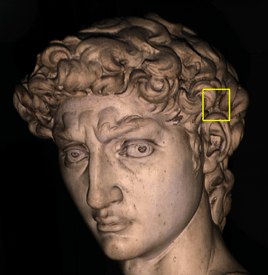Filling holes in complex surfaces using volumetric diffusion
James Davis,
Stephen R. Marschner,
Matt Garr, and
Marc Levoy
First International Symposium on
3D Data Processing, Visualization, and Transmission
Padua, Italy, June 19-21, 2002


|
|
At left is a photograph of the head of Michelangelo's David. At right is a
rendered 3D model of a section of his hair (corresponding to the square in the
photograph). The section is 75mm wide on the statue, and the spacing between
triangle vertices is 1.0mm. Although this surface was scanned dozens of times
(from many different angles), occlusions prevented access to the deepest
crevices. The hole highlighted in this rendering has a complex shape and
multiple boundary components, i.e. islands floating in the hole. The largest
boundary component contains 905 edges. (Hidden portions of this boundary are
indicated with broken lines.) In this paper, we present an algorithm that can
fill this hole.
|
Abstract
We address the problem of building watertight 3D models from surfaces that
contain holes - for example, sets of range scans that observe most but not all
of a surface. We specifically address situations in which the holes are too
geometrically and topologically complex to fill using triangulation
algorithms. Our solution begins by constructing a signed distance function,
the zero set of which defines the surface. Initially, this function is
defined only in the vicinity of observed surfaces. We then apply a diffusion
process to extend this function through the volume until its zero set bridges
whatever holes may be present. If additional information is available, such
as known-empty regions of space inferred from the lines of sight to a 3D
scanner, it can be incorporated into the diffusion process. Our algorithm is
simple to implement, is guaranteed to produce manifold non-interpenetrating
surfaces, and is efficient to run on large datasets because computation is
limited to areas near holes.
Paper
Note:
This paper is a revision of TR-2001-08,
which was in turn a revision of TR-2001-07.
Don't bother reading those papers; the present one completely supercedes them.
Software
Click here to download the
software described in this paper.
© Copyright 2002 by Marc Levoy

